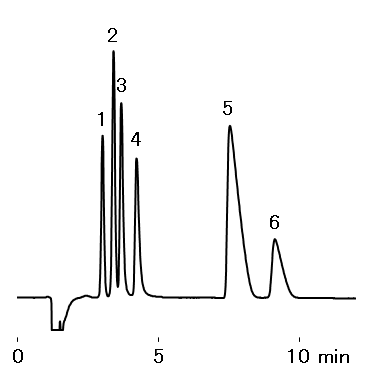Monovalent and divalent cation standards were analyzed using IC YK-421 (a column for cation analysis).
(Advantage of Phosphoric acid eluent)
The standard eluent of IC YK-421 is tartaric acid / dipicolinic acid eluent, but the storage stability of this eluen is poor and The solubility of the reagents used for eluent is also low, It was not possible to prepare the concentrated solution. On the other hand, phosphoric acid eluent is possible to save about one week and the concentrated solution (1 mol/L) can be sotred for a long term (six months).
(The difference)
(1) Mg2+ ion elutes after the Ca2+ ions in the case of tartaric acid / dipicolinic acid-based eluent, but elution order of Ca2+ ion and Mg2+ ion is reversed in the case of phosphoric acid-based eluent.
(2) Transition metal ions are eluted at a position of Vo in the tartaric acid / dipicolinic acid eluent, but eluted collectively between Ca2+ ion and Mg2+ ion in the phosphoric acid-based eluent. Therefore, we do not recommend the use of phosphate eluent, if you want to analyze a sample containing a large amount of transition metal ions.
(3) Background of phosphoric acid eluent is higher than tartaric acid / dipicolinic acid eluent.
Please refer to YK-421 (tartaric acid + dipicolinic acid eluent)
Sample : 20 μL
1. Li+ 2 mg/L
2. Na+ 10 mg/L
3. NH4+ 10 mg/L
4. K+ 20 mg/L
5. Mg2+ 10 mg/L
6. Ca2+ 20 mg/L
Column : Shodex IC YK-421 (4.6 mm I.D. x 125 mm) Eluent : 4 mM H3PO4 aq. Flow rate : 1.0 mL/min Detector : Non-suppressed conductivity Column temp. : 40 °C
Sample Name Index
Operation Manual / Certificate of Analysis
Operation Manuals and Certificate of Analysis / Inspection Certificate for the following products can be downloaded here.
Product Name Index
Applications
- Monovalent and Divalent Cation Standards (1) (YK-421)
- Monovalent and Divalent Cation Standards (2) (YK-421)
- Monovalent and Divalent Cation Standards (3) (Dipicolinic Acid + Crown Ether Eluent) (YK-421)
- Monovalent and Divalent Cation Standards (5) (YK-421) (Phosphoric Acid + 18-Crown 6-Ether Eluent)
- Monovalent and Divalent Cation Standards (6) (Comparison of YS-50 and YK-421)
- Monovalent and Divalent Cation Standards (7) (Eluent Conteinig Acetonitrile) (YS-50)
- Monovalent and Divalent Cation Standards (8) (Ethylenediamine Containing Sample) (YS-50)
- Dynamic Range of Column (YK-421)
- High Sensitive Detection of Cations (YK-421)
- Effects of Acetonitrile Concentration on Elution Volume (YK-421)
- Effects of Methanesulfonic Acid Concentration on Elution Time (YS-50)
- Effects of Flow Rate on Plate Number (YS-50)
- Effects of Temperature (YS-50)
- Effects of Sample Load on Plate Number (YS-50)
- Linearity of Calibration Curves (YS-50)
- Effects of Crown Ethers (YS-50)
- Tap Water (1) (YK-421)
- Analysis of Tap Water (2) (YK-412) (Phosphoric Acid Eluent)
- Monovalent and Divalent Cations Analysis in Tap Water (Ethylenediamine Containing Sample) (YS-50)
- Monovalent and Divalent Cations Analysis in River Water (Ethylenediamine Containing Sample) (YS-50)
- Mineral Water (YS-50)
- Sea Water (2) (YS-50)
- Red Wine (1) (YK-421)
- Red Wine (3) (YS-50)
- Serum (YK-421)
- Long Chain Alkylamines (YK-421)
- Trialkylamines (YK-421)
- Tetraalkylammoniums (YK-421)
- Analysis of Tetraalkylammoniums (YS-50)
- Alkylamines (2) (YK-421) (Phosphoric Acid + Acetonitrile)
- Ethanolamines and Alkylamines (YK-421) (Phosphoric Acid + Acetonitrile)
- Analysis of Ethanolamines and Alkylamines (YS-50)
- Cations and Alkylamines (YS-50)
- Analysis of Methylamines (YS-50)
- Analysis of Ethylamines (YS-50)
- Analysis of Short Chain Alkylamines (YS-50)
- Cation Analysis in the Presence of PEG (YS-50)
- Cation Analysis in the Presence of Albumin (YS-50)
- Quantification of N-Methylpyrrolidine in Cefepime for Injection According to USP-NF Method (YK-421)
